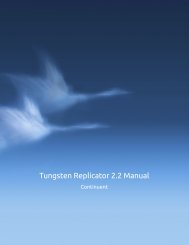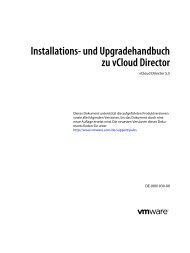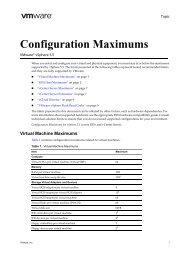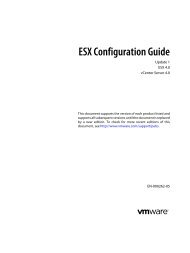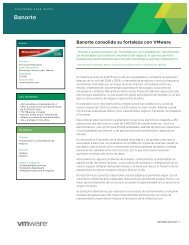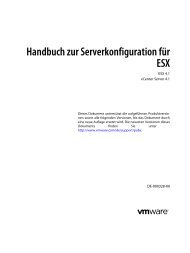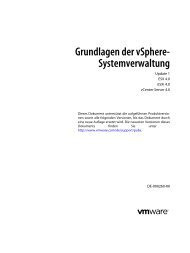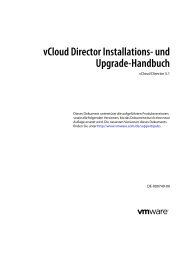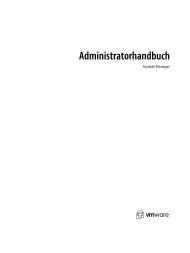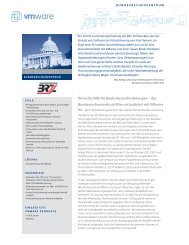Getting Started with vFabric Hyperic v.5.7 - VMware
Getting Started with vFabric Hyperic v.5.7 - VMware
Getting Started with vFabric Hyperic v.5.7 - VMware
Create successful ePaper yourself
Turn your PDF publications into a flip-book with our unique Google optimized e-Paper software.
One-Step Migration ProcedureNote: In this procedure "one-step" refers the fact that export and import processes comprise asingle step.Define JAVA_HOMEBefore running the one-step migration procedure, set the JAVA_HOME environmentvariable to point to the JRE that the target (5.7) <strong>vFabric</strong> <strong>Hyperic</strong> Server runs in.In the process described in Migration Procedure above, you run the migration in two steps —first you export data from your previous <strong>vFabric</strong> <strong>Hyperic</strong> Server installation, then you import thatdata into your <strong>vFabric</strong> <strong>Hyperic</strong> 5.7 environment.If both the source and destination directories and databases are accessible from a singlemachine, either because they physically reside there, or are mounted on your file system, youcan perform a one-step-migration, in which you initiate export and import <strong>with</strong> a singlecommand.As noted above in Account Permission Requirements execute the migration process under thesame user account used to install the <strong>vFabric</strong> <strong>Hyperic</strong> 5.7 Server. Note also the database userrequirements described in Step 3: Import Server Configuration and Database.After performimg Step 1: Install <strong>vFabric</strong> <strong>Hyperic</strong> 5.7 Server and vPostgreSQL you can run aone-step-migration, supplying arguments at the command line, <strong>with</strong> a command in this form:./hq-migrate.sh -Dsource.hqserver.install.path=SourceServerHome-Dtarget.hqserver.install.path=TargetServerHomeNote: Enter the command on a single line.Specify Migration Options in a Properties FileIn the instructions provided above for two-step and one-step procedures, you supply commandarguments — such as the source and target server installation directories — on the commandline. Alternatively, you can define the command arguments in a properties file, and specify thefile location at the command line.You define the desired command arguments as name=value pairs.For example, instead of typing this command:./hq-migrate.sh hq-export -Dhqserver.install.path=/opt/<strong>vFabric</strong> <strong>Hyperic</strong>46/server-4.6.0-EE84



